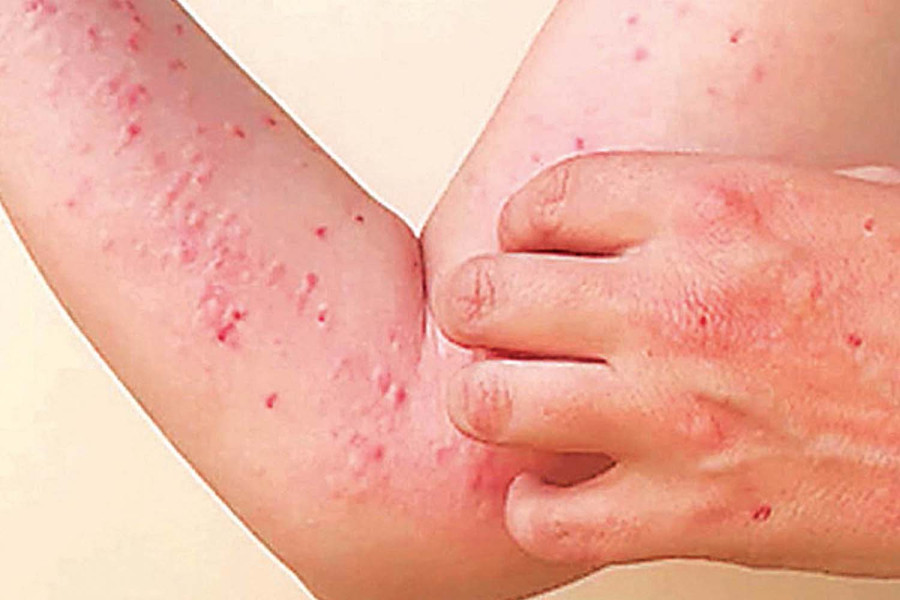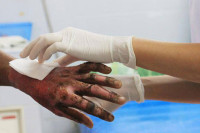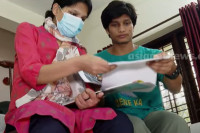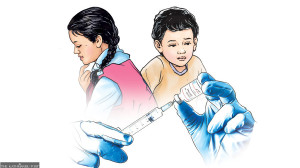Health
Migrant workers’ living conditions in focus after new mpox cases in Nepal
Health authorities mull community-level surveillance to prevent the virus from spreading further.
Arjun Poudel
The second and third cases of mpox recently confirmed in Nepal were migrant workers who returned from Saudi Arabia 10 days apart.
Doctors who recorded the case history of the second patient, a 36-year-old man, said he admitted to having sexual contact just a few days before returning to Nepal.
However, the third patient, a 44-year-old man, denied having any sexual contact but said other members sharing his room had symptoms that matched his own. This hints at the unsafe working and living conditions faced by migrant workers in Gulf countries like Saudi Arabia.
“Thousands of Nepalis are working in West Asia,” said Dr Sher Bahadur Pun, chief of the Clinical Research Unit at Sukraraj Tropical and Infectious Disease Hospital. “Most are low-skilled workers in sectors like construction, manufacturing, and hospitality, and are exposed to numerous health risks. Poor living and working conditions, and lack of access to healthcare make them highly vulnerable to health risks including deadly diseases.”
These two mpox cases point to the hazardous conditions and risky behaviours of Nepali migrant workers. Several international studies also show that migrant workers, including Nepalis, are exposed to multiple health risks, including extreme heat, long work hours, abusive working environment and forced labour.
The third mpox patient told doctors that he shared an apartment with 40 other migrant workers from India, Bangladesh, Sri Lanka and the Philippines.
“The apartment is overcrowded and the sanitary conditions are poor,” a doctor who attended the patient quoted him as saying. “Had there been better healthcare access for migrant workers, the problems could have been identified before the infected persons returned home.”
What alarmed public health experts was the unsafe and unhygienic living conditions of migrant workers, who are highly vulnerable to deadly diseases and can easily bring these into the country.
The first case of mpox infection in Nepal was detected in a 60-year-old foreign national in 2023.
“We should not forget that the first case of Covid in Nepal was detected in a student who returned from Wuhan, China. Similarly, several other cases were linked to international travellers or migrant workers returning from Gulf countries or India,” said Pun. “Due to our poor surveillance systems, any deadly disease outbreak in any corner of the globe has a high chance of reaching Nepal.”
In the second and third mpox cases, the infected persons sought treatment upon arrival and remained in hospital isolation.
Experts, however, warn that not all infected persons show symptoms immediately, and some may remain asymptomatic, which will increase the risk of spread of the virus in communities.
Thousands of international travellers, including migrant workers, return to Nepal every day, and almost all of them go directly to their homes, where they interact with their families.
As the incubation period for the virus is 5 to 21 days, some of the infected show no symptoms, and such people can easily pass on the germs to their spouses and other family members.
“We must step up surveillance measures, and it should not be limited to international airports,” said Dr Prabhat Adhikari, an infectious disease expert. “Raising awareness is vital to preventing outbreaks. Awareness programme should be launched specifically targeting migrant workers.”
Health officials acknowledge the poor living conditions of migrant workers, their risky sexual behaviours, lack of access to healthcare in host countries, and the risk of the virus spreading in Nepali communities.
“We have already alerted local dermatologists to the risks of mpox spread and stepped up surveillance measures,” said Dr Yadu Chandra Ghimire, director at the Epidemiology and Disease Control Division. “We are also considering expanding surveillance to the community level.”
Public health experts in Nepal say screenings at health desks at international airports and land crossings are insufficient to prevent outbreaks, as mpox symptoms can take up to 21 days to appear, and many cases can go undetected at health desks.
Mpox is a rare disease caused by infection with the mpox virus. Monkeypox cases have been reported in neighbouring India, with which Nepal shares a long, porous border. India has recorded at least 30 mpox infections since 2022.
Health experts say that even though mpox is usually mild and most people recover within weeks, the risks should not be underestimated. They stress the importance of precautions, saying that any disease seen in any corner of the world can reach Nepal due to the high mobility of people.
Since 2022, mpox has spread globally. More than 100,000 people from 122 countries have already tested positive for the disease.
Along with sexual transmission, the potentially deadly disease can be transmitted through respiratory droplets, to children through skin-to-skin contact with caregivers, as well as through needle injuries and occupational exposures due to a lack of personal protective measures.
As the disease primarily spreads through close person-to-person contact, public health experts recommend self-isolation and good hygiene to prevent transmission.
Its symptoms include fever, headache, swelling, body aches, sore throat, muscle aches, back pain, exhaustion, and itchy rashes on the face, hands, and feet.
The World Health Organisation has said that mpox is treated with supportive care for symptoms such as pain and fever, with close attention to nutrition, hydration, skin care, prevention of secondary infections, and treatment of co-infections.




 19.12°C Kathmandu
19.12°C Kathmandu














